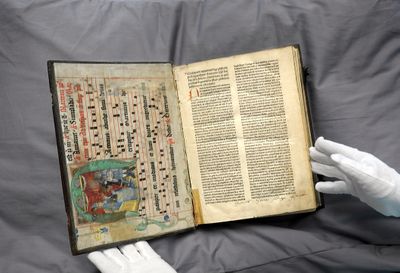Rare and beautiful
Special Collections section of GU’s Foley Center Library holds unique treasures

It is possible to literally touch the past, to see centuries-old history and culture right before you and, sometimes, actually hold it in your hand – right here in Spokane.
This can be done in several of our libraries. In addition to providing research and general reading resources, the libraries of the region are the repositories of some exceedingly rare and valuable books and historic records from long ago that come from assorted continents and cover a variety of subject matter.
One such book is the first edition Psalter (book of Psalms) owned by Bruno of Wurzburg (Germany), the noted Christian scholar. This 1475 volume of Psalms, printed on one of the first printing presses to use moveable type, resides in Special Collections of Gonzaga University’s Ralph E. and Helen Higgins Foley Center Library. It is the oldest printed book in the library’s collection.
Stephanie Plowman, associate professor and Special Collections librarian, said the book, printed in black and red, has its original binding of pigskin over pine boards with brass clasps and green edges. There are two columns of printed Latin text per page, one containing the Psalm itself and the other a commentary by Bruno, who was a bishop.
The first page of the first psalm is hand-painted with colored ink and gold gilding. The inside front cover has a pastedown showing musical notes on a four-line music staff (rather than today’s five-line staff), which comes from Catholic worship, Plowman said.
It is a beautiful and exceedingly rare book, said Plowman, who noted that from time to time, the Psalter and other rare books are put on display so the public, not just scholars and researchers, can view and enjoy them.
Among a few of the many other rare works at Gonzaga are the manuscripts of the English Jesuit poet Gerard Manley Hopkins and nine first-edition titles by Charles Dickens, from 1837-65, which were printed in installments.
Plowman said Dickens’ “David Copperfield” was originally printed in serial format, as the work was intended to be read over a period of time, and these first editions also reside in Special Collections.
Also housed there are the Archives of the Oregon Province of the Society of Jesus, a 3,000-volume of philosophy, theology, literature and art from the 16th through 18th centuries.
Researchers often visit Special Collections for this wealth of material. This summer Linda Carroll, professor of Italian at Tulane University, spent six weeks examining the Oregon Province’s early 16th century volumes on theology that had been printed in Venice.
“What is so wonderful is that this collection has volumes not known to exist any place else in the world and also that the early readers made written comments in the margins, which tells me a great deal about what seemed important at the time,” Carroll said. “This is an incredibly rich collection.”
Such richness of historic documents is not limited to university libraries. At the Northwest Room of the downtown Spokane Public Library, for example, there is a 1475 volume of Bishop Petrus Lombardus’ “Libri Quattuor Sententiarum” (Four Books of Sentences), which was the standard theology textbook at medieval universities.
Northwest librarian Rayette Sterling said their George Fuller Collection, named for the historian and author who was Spokane’s first city librarian, also contains cuneiform clay tablets from Egypt, some more than 4,000 years old, a dictionary by Noah Webster from 1806 and a first edition of “Uncle Tom’s Cabin.”
There truly is a great depth and variety of history within the region’s libraries, including those at Eastern Washington University and Washington State University.
“The value in these rare and historic documents is that they help us maintain our cultural heritage,” Gonzaga’s Plowman said. “That’s how we keep contact with our past, by being able to see, touch and hold something that is more than five centuries old. It keeps it very real.”